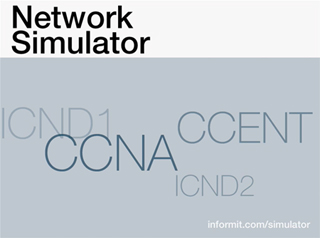Register your product to gain access to bonus material or receive a coupon.
CCENT 640-822 Network Simulator: Software Download
- By Wendell Odom
- Published Jan 15, 2009 by Pearson IT Certification. Part of the Network Simulator series.
Software Download
- This product currently is not for sale.
Audio & Video
Video

You need to upgrade your Flash Player. You need version 9 or above to view this video. You may download it here. You may also see this message if you have JavaScript turned off. If this is the case, please enable JavaScript and reload the page.
Description
- Copyright 2009
- Dimensions: 8-1/2 X 11
- Edition: 1st
- Software Download
- ISBN-10: 1-58720-217-4
- ISBN-13: 978-1-58720-217-9
CCENT 640-822 Network Simulator helps you develop and improve hands-on configuration and troubleshooting skills without the investment in expensive lab hardware. This state-of-the-art, interactive simulation software enables you to practice your networking skills with 98 structured labs designed to help you learn by doing, which is the most effective method of learning.
Experience realistic network device response as you work through each of the labs, which include detailed instructions, topology diagrams, hints, and full solutions. Unlike other simulators on the market, the lab scenarios included in the CCENT 640-822 Network Simulator are far more complex, challenging you to learn how to perform realistic network configuration and troubleshooting tasks.
CCENT 640-822 Network Simulator is available only as a download, and is a subset of the CCNA 640-802 Network Simulator, covering all the ICND1 topics.
The system requirements are:
• 500 MHz or higher processor
• 512 MB RAM (1 GB recommended)
• 500 MB hard drive space
• 32-bit true color monitor (1024x768 resolution)
• Microsoft Windows XP Professional with SP2, Microsoft Vista, or Mac OS X Version 10.4.11
• Java Runtime Environment (JRE) version 1.5.0
• Adobe Acrobat Reader 8.0
TOCSkill Builders
Switch CLI Exec Mode
Switch CLI Configuration Process (2 Labs)
Router CLI Exec Mode (2 Labs)
Router CLI Configuration Process
Setting Switch Passwords
Configuring Switch IP Settings
Setting Router Passwords
Configuring Router IP Settings
Configuring Local Usernames
Using and Suspending Telnet Connections
Configuring SSH
Migrating to a New IOS® Image
Setting the Configuration Register
Comparing Configuration Files
Examining the IP Routing Table
Using debug
Testing Using Pings with Hostnames
Ignoring the Startup-config File
Booting a New Router IOS
Terminal History I
Terminal History II
Topology Analysis
LAN Switching
Interface Settings (3 Labs)
Switch Forwarding I
Switch IP Connectivity I
Interface Status (4 Labs)
Switch Security (4 Labs)
Configuring IP Addresses (4 Labs)
Connected Routes
Static Routes (4 Labs)
Default Routes
IP Classless
Subnet Zero (2 Labs)
Loopback Interfaces
RIP Configuration (6 Labs)
RIP Verification (2 Labs)
Configuring Hostnames
PC IP Commands (3 Labs)
Serial Link Configuration (4 Labs)
Interface Status (2 Labs)
Configuration Scenarios
Configuration Scenarios
The Initial Configuration Dialogue (Setup)
New Job I
Rebuild a Configuration
SSH and Telnet
LAN Switching
Switch Interfaces and Forwarding
Switch IP Connectivity
Switch Security
Configuring VLANs
Subnetting and Addressing (3 Labs)
Static Routing (2 Labs)
RIP-2 Configuration (2 Labs)
RIP Auto-summary
Serial Link Configuration I
IP and MAC Address Comparisons
IP Classless
Troubleshooting Scenarios
Switch Forwarding I
Path Analysis I
Port Security
Network Discovery (2 Labs)
Addressing and Routing
IP Routing I
The system requirements are:
• 500 MHz or higher processor
• 512 MB RAM (1 GB recommended)
• 500 MB hard drive space
• 32-bit true color monitor (1024x768 resolution)
• Microsoft Windows XP Professional with SP2, Microsoft Vista, or Mac OS X Version 10.4.11
• Java Runtime Environment (JRE) version 1.5.0
• Adobe Acrobat Reader 8.0
Sample Content
Table of Contents
Skill Builders
Switch CLI Exec Mode
Switch CLI Configuration Process (2 Labs)
Router CLI Exec Mode (2 Labs)
Router CLI Configuration Process
Setting Switch Passwords
Configuring Switch IP Settings
Setting Router Passwords
Configuring Router IP Settings
Configuring Local Usernames
Using and Suspending Telnet Connections
Configuring SSH
Migrating to a New IOS® Image
Setting the Configuration Register
Comparing Configuration Files
Examining the IP Routing Table
Using debug
Testing Using Pings with Hostnames
Ignoring the Startup-config File
Booting a New Router IOS
Terminal History I
Terminal History II
Topology Analysis
LAN Switching
Interface Settings (3 Labs)
Switch Forwarding I
Switch IP Connectivity I
Interface Status (4 Labs)
Switch Security (4 Labs)
Configuring IP Addresses (4 Labs)
Connected Routes
Static Routes (4 Labs)
Default Routes
IP Classless
Subnet Zero (2 Labs)
Loopback Interfaces
RIP Configuration (6 Labs)
RIP Verification (2 Labs)
Configuring Hostnames
PC IP Commands (3 Labs)
Serial Link Configuration (4 Labs)
Interface Status (2 Labs)
Configuration Scenarios
Configuration Scenarios
The Initial Configuration Dialogue (Setup)
New Job I
Rebuild a Configuration
SSH and Telnet
LAN Switching
Switch Interfaces and Forwarding
Switch IP Connectivity
Switch Security
Configuring VLANs
Subnetting and Addressing (3 Labs)
Static Routing (2 Labs)
RIP-2 Configuration (2 Labs)
RIP Auto-summary
Serial Link Configuration I
IP and MAC Address Comparisons
IP Classless
Troubleshooting Scenarios
Switch Forwarding I
Path Analysis I
Port Security
Network Discovery (2 Labs)
Addressing and Routing
IP Routing I